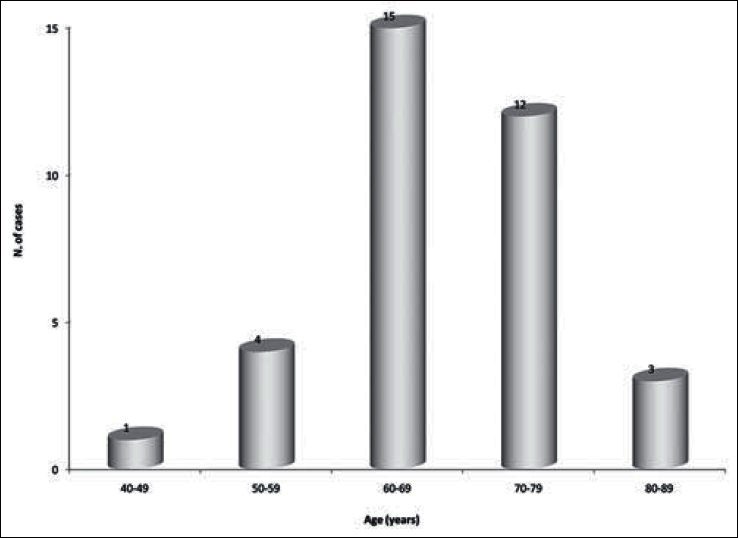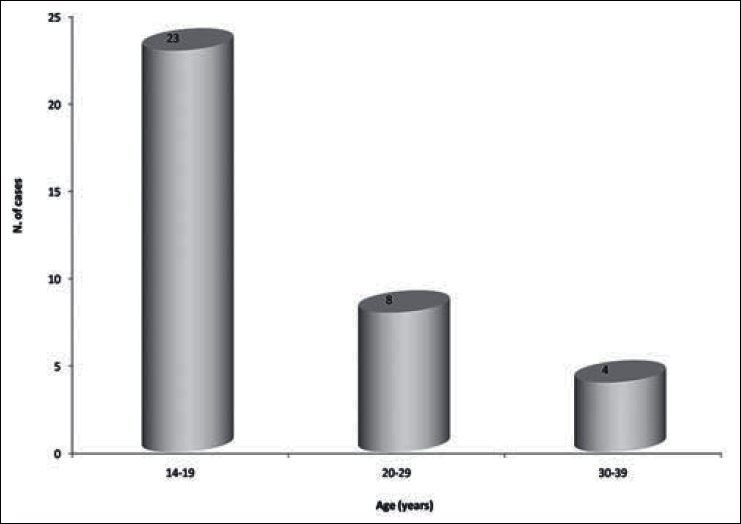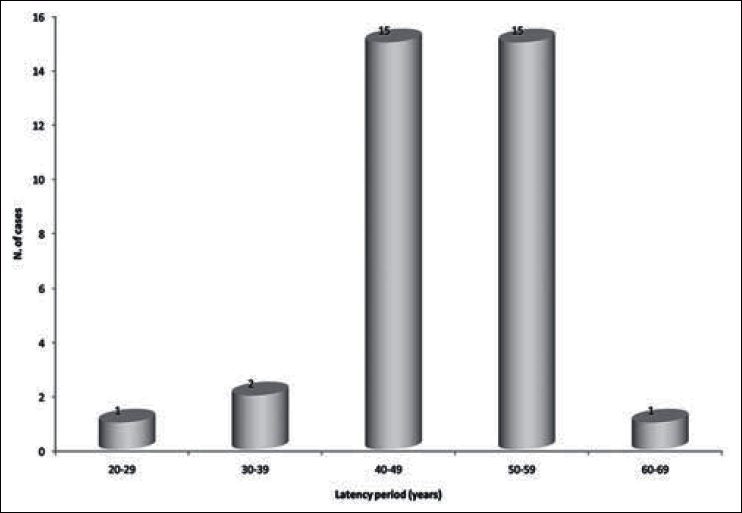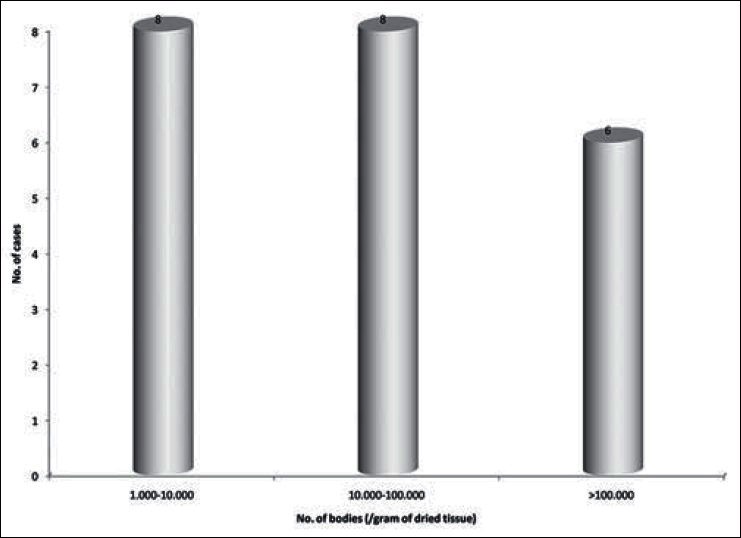Abstract
Background:
The high mesothelioma incidence in Monfalcone, Italy, is mainly attributable to shipbuilding activity. Mesothelioma risk among shipyard workers in Monfalcone is poorly defined.
Materials and Methods:
Workers hired at the Monfalcone shipyards in the period 1950-1959 were identified by surveying shipyard roll. The list of the workers was coupled with the archive data of Monfalcone and Trieste Hospitals. Mesotheliomas diagnosed in the above people were reexamined.
Results:
Of 1,403 workers hired in 1950-1959, 35 were diagnosed with mesothelioma (34 pleural, one peritoneal) between 1978 and 2012. Latency periods exceeded 40 years in 31 cases. The highest percentage of mesotheliomas was observed among people aged 14–19 years at hiring time (3.4%). Four mesothelioma patients had a blood relative with the same tumor.
Conclusions:
The present findings show high mesothelioma percentage among shipyard workers hired at young ages. The effects of asbestos exposure begun in 1950-1959 cannot be considered as exhausted.
Keywords: Age, asbestos, asbestos bodies, familial mesothelioma, latency period, mesothelioma, peritoneum, pleura, shipyards
INTRODUCTION
Monfalcone, Northeastern Italy, is the site of large shipyards. These began their activity in 1908. The Monfalcone district has been characterized as an area at high incidence of malignant mesothelioma and shipyard work has emerged as the principal cause of mesothelioma in Monfalcone.[1,2] Studies conducted on a series of 3,640 consecutive necropsies showed that in the Monfalcone shipyards, asbestos exposure was an ubiquitous phenomenon, often reaching high levels.[3] Recent studies have been conducted, aimed at obtaining data on the magnitude of mesothelioma risk in the Monfalcone shipyards as well as the features of such tumor in different periods. In a series of 2,776 persons hired in 1942, 18 pleural mesotheliomas were diagnosed in the period 1981-2005.[4] Of 1,637 workers hired in the period 1960-1969, 17 had a diagnosis of pleural mesothelioma.[5] In the present study, people hired at the Monfalcone shipyards in the period 1950-1959 were investigated.
MATERIALS AND METHODS
The Monfalcone shipyards roll was examined to identify the persons hired in the period 1950-1959. Available data were registered including: Name and family name of the worker, birth year (or complete birth date when reported), employment date, trade at the hiring time. The list of hired workers was coupled with archive data collected at the Pathological Anatomy Units of the Monfalcone and Trieste Hospitals. Mesothelioma cases diagnosed in the workers hired in 1950-1959 were reexamined. In particular we reviewed the pathological diagnosis (type and date), occupational history, latency period (time intervals elapsing between hiring year and mesothelioma diagnosis), and markers of asbestos exposure (presence/burden of asbestos bodies in lung tissue). In many cases asbestos bodies had been counted after isolation from lung tissue, following Smith-Naylor method.[6]
The Chi-square and the Student′s t-test were used to compare the prevalences of mesothelioma in the various age groups at hiring time.
RESULTS
In the period 1950-1959, 1,403 workers (1,375 men, and 28 women, aged between 14–59 years) were hired at the Monfalcone shipyards. The age distribution of the male workers is reported in Figure 1. The Figure 2 shows the principal trades of the male workers. Of the 28 female workers, 21 were hired as canteen employees.
Figure 1.

Age distribution at hiring time in 1,374* male workers, hired at the Monfalcone shipyards in the period 1950-1959. *In one case the age of the worker was not reported
Figure 2.

The most prevalent trades at hiring time in 1,375 male workers hired at the Monfalcone shipyard in the period 1950-1959
Thirty-five cases of malignant mesothelioma (34 pleural, one peritoneal) were diagnosed among people hired in the period 1950-1959. Mesothelioma patients included 34 men aged between 47 and 82 years and one woman aged 88 years. The age distribution of the patients with mesothelioma is showed in Figure 3. The tumors were diagnosed between 1978 and 2012. The pathological diagnosis was based on or confirmed by necropsy findings in 27 cases. In the remaining cases, mesothelioma was diagnosed on biopsy or surgical material (seven cases), or on cytological findings (one case).
Figure 3.

Age distribution at the time of diagnosis in 35 mesothelioma cases, diagnosed among people hired at the Monfalcone shipyards in the period 1950-1959
Figure 4 shows the age distribution of the mesothelioma patients at the employment time. Mesotheliomas were concentrated among persons aged 14–33 years at hiring date. The highest prevalence was observed among people aged 14–19 years at hiring time [Table 1]. The differences among the various groups did not reach the statistical significance.
Figure 4.

Age distribution at hiring time in 35 mesothelioma cases, diagnosed among people hired at the Monfalcone shipyards in the period 1950-1959
Table 1.
Percentages of mesotheliomas after the age at hiring time among male workers hired at the Monfalcone shipyards in 1950-1959

The trades of the workers with mesothelioma were various. Not rarely, the patients had worked with more trades, with plumber (11 cases), carpenter-shipwright (ten cases), and welder (six cases) being the more frequent. Two men had histories of asbestos exposure prior to the employment in 1950s. The woman with mesothelioma had worked as a canteen employee. She had also a history of exposure to asbestos at home, having cleaned the work clothes of her husband and of her son, occupationally exposed.
Of 29 patients for whom data on the employment duration were available, 28 had worked in the shipyards for more than 10 years, and 25 for more than 20 years. The latency periods calculated in 34 cases ranged between 25 and 68 years (mean 48.3 years) [Figure 5].
Figure 5.

Latency periods in 34 mesothelioma cases, diagnosed among people hired at the Monfalcone shipyards in the period 1950-1959
Asbestos bodies isolated in 22 cases ranged between 1,000 and 886,000 bodies per gram of dried tissue [Figure 6]. In a further six cases, the presence of asbestos bodies on routine lung sections was reported.
Figure 6.

Asbestos body burdens in 22 mesothelioma cases, diagnosed among people hired at the Monfalcone shipyards in the period 1950-1959
Four men with pleural mesothelioma had a blood relative with the same tumor. Familial mesotheliomas included one couple father-son, one couple of brothers, and two couples brother-sister. Of the blood relatives, three had histories of occupational exposure to asbestos and one had a history of domestic exposure.
DISCUSSION
The cancer geography clearly shows the relationship between shipbuilding activity and development of malignant mesothelioma. Since the 1950s, the sites with largest shipyards have been identified as areas at high mesothelioma incidence.[7,8] Some cohort studies showed high mesothelioma incidence/mortality among shipyard workers.[9–12]
After the destruction caused by the raids in World War II (WWII), the Monfalcone shipyards had an intense activity in the decade 1950-1959 and in the following years. Units of various types were produced; including passenger motorships and turbine steamships, turbine tankers, and warships (air carrier cruiser and many submarines).
In the Monfalcone district, studies on mesothelioma began in 1979.[13] This means that mesotheliomas developed prior to this date may be remained undetected or unregistered. Consequently, the data emerged from the present study may be underestimated. Moreover, the fact that mesothelioma cases have been observed even in 2012, suggests that further cases have to be expected as effects of shipyard work in Monfalcone in 1950-1959. Finally, archive data of Monfalcone and Trieste Hospitals do not cover all cases, especially in case of people migrating to other areas. Despite to these limitations, the prevalence of mesothelioma among shipyard workers was high.
The relative rarity of peritoneal mesothelioma in the present study corresponds to that seen in more large series examined in Monfalcone.[1,14]
A relevant factor in determining the risk of mesothelioma is the age at the hiring time. In the present series, nearly 50% of people hired in 1950-1959 were aged 14–19 years at the time of employment. In this group, the prevalence of mesothelioma reached the highest values. This fact is not difficult to explain. People hired at young age may have experienced longer exposures to asbestos. Moreover, the development of mesothelioma generally requires very long latency periods. The studies conducted in the Trieste-Monfalcone area[1,15–18] showed mean latency periods close to 50 years among shipyard workers. Similar values, somewhat higher than those currently reported, were also observed in other shipyard areas.[19] Older people at hiring time die before they might reach mesothelioma age. It should be noted that asbestos exposure represents a risk factor for a wide spectrum of pathological conditions, that are not entirely known. Besides the malignancies certainly or possibly related to asbestos,[20] some studies indicate also a higher risk for cardiovascular diseases among asbestos exposed persons.[21]
The latency periods observed in the present mesotheliomas showed extreme variations, from 25 to 68 years. The mean latency period was superimposable to that observed in large series of mesotheliomas among shipyard workers in the Trieste-Monfalcone area.[18]
Lung asbestos bodies isolated at necropsy in 22 mesothelioma cases showed wide variations in number. In 14 cases, high burdens (more than 10,000 bodies per gram of dried tissue) were found. In evaluating these findings, it should be remembered that clearance of asbestos fibers from the lung tissue represents a mechanism by far more efficient than believed in the past.[22] Clearance involves, although at different degrees, both chrysotile as well as amphiboles. If long time intervals have elapsed from the end of asbestos exposure, the number of lung asbestos bodies reflects only partly the intensity of occurred exposure. Moreover, asbestos body burdens in the lung tissue may differ from those of pleura. Studies conducted on lung and pleural tissues obtained at necropsy in a small group of Monfalcone shipyard workers showed that the number as well as the type of asbestos fibers in the pleura differed markedly from those found in the lung.[23] Even with these limitations, lung asbestos body burdens offer relevant data on the entity of exposure.
In general, asbestos is the cause of mesothelioma in nearly 100% of the cases. Nevertheless, the percentages of exposed people who develop mesothelioma are relatively low. This indicates the role of cofactors in the genesis of asbestos-related mesothelioma.[24,25] Such cofactors are poorly known. A lot of investigations have been devoted to familial mesothelioma.[26–29] The meaning of familial aggregations in malignant mesothelioma has been variously interpreted. After the data recently reported by de Klerk et al.,[30] from Wittenoom, Australia, familial aggregations in mesothelioma occur more frequently than expected. This suggests an important genetic component in mesothelioma.[30] The presence of four cases of familial mesothelioma in the present series agrees with the view that genetic susceptibility has a relevant role in asbestos-related mesothelioma. In conclusion, the current results indicate a high mesothelioma risk among workers hired at the Monfalcone shipyards in 1950-1959. A further observation period is needed to evaluate the entire impact of asbestos exposure begun in the Monfalcone shipyards in the above decade.
Footnotes
Source of Support: Cassa di Risparmio di Gorizia Foundation
Conflict of Interest: None declared.
REFERENCES
- 1.Bianchi C, Brollo A, Ramani L, Zuch C. Asbestos-related mesothelioma in Monfalcone, Italy. Am J Ind Med. 1993;24:149–60. doi: 10.1002/ajim.4700240203. [DOI] [PubMed] [Google Scholar]
- 2.Bianchi C, Brollo A, Ramani L, Bianchi T. Malignant mesothelioma of the pleura in Monfalcone, Italy. A 23-year monitoring in an area at high incidence. Eur J Oncol Library. 2004;3:49–58. [Google Scholar]
- 3.Bianchi C, Brollo A, Ramani L. Asbestos exposure in a shipyard area, Northeastern Italy. Ind Health. 2000;38:301–8. doi: 10.2486/indhealth.38.301. [DOI] [PubMed] [Google Scholar]
- 4.Bianchi C, Bianchi T. Shipbuilding and mesothelioma in Monfalcone, Italy. Indian J Occup Environ Med. 2012;16:14–7. doi: 10.4103/0019-5278.99682. [DOI] [PMC free article] [PubMed] [Google Scholar]
- 5.Bianchi C, Bianchi T. Shipbuilding and mesothelioma in the Monfalcone area, Italy. Trend of the epidemic. Eur J Oncol. 2012;17:43–8. [Google Scholar]
- 6.Smith MJ, Naylor B. A method for extracting ferruginous bodies from sputum and pulmonary tissue. Am J Clin Pathol. 1972;58:250–4. doi: 10.1093/ajcp/58.3.250. [DOI] [PubMed] [Google Scholar]
- 7.McCaughey WT. Primary tumours of the pleura. J Pathol Bacteriol. 1958;76:517–29. doi: 10.1002/path.1700760222. [DOI] [PubMed] [Google Scholar]
- 8.Bianchi C. Mesothelioma and naval work. Eur J Oncol. 2002;7:159–60. [Google Scholar]
- 9.Kolonel LN, Yoshizawa CN, Hirohata T, Myers BC. Cancer occurrence in shipyard workers exposed to asbestos in Hawaii. Cancer Res. 1985;45:3924–8. [PubMed] [Google Scholar]
- 10.Danielsen TE, Langård S, Andersen A, Knudsen O. Incidence of cancer among welders of mild steel and other shipyard workers. Br J Ind Med. 1993;50:1097–103. doi: 10.1136/oem.50.12.1097. [DOI] [PMC free article] [PubMed] [Google Scholar]
- 11.Puntoni R, Merlo F, Borsa L, Reggiardo G, Garrone E, Ceppi M. A historical cohort mortality study among shipyard workers in Genoa, Italy. Am J Ind Med. 2001;40:363–70. doi: 10.1002/ajim.1110. [DOI] [PubMed] [Google Scholar]
- 12.Krstev S, Stewart P, Rusiecki J, Blair A. Mortality among shipyard Coast Guard workers: A retrospective cohort study. Occup Environ Med. 2007;64:651–8. doi: 10.1136/oem.2006.029652. [DOI] [PMC free article] [PubMed] [Google Scholar]
- 13.Bianchi C, Brollo A, Bittesini L. Mesothelioma caused by asbestos in the Monfalcone area. Pathologica. 1981;73:649–55. [PubMed] [Google Scholar]
- 14.Bianchi C, Bianchi T. Malignant mesothelioma of the peritoneum and heavy exposure to asbestos. Eur J Oncol. 2007;12:255–8. [Google Scholar]
- 15.Giarelli L, Bianchi C, Grandi G. Malignant mesothelioma of the pleura in Trieste, Italy. Am J Ind Med. 1992;22:521–30. doi: 10.1002/ajim.4700220407. [DOI] [PubMed] [Google Scholar]
- 16.Bianchi C, Giarelli L, Grandi G, Brollo A, Ramani L, Zuch C. Latency periods in asbestos-related mesothelioma of the pleura. Eur J Cancer Prev. 1997;6:162–6. [PubMed] [Google Scholar]
- 17.Bianchi C, Brollo A, Ramani L, Bianchi T, Giarelli L. Asbestos exposure in malignant mesothelioma of the pleura: A survey of 557 cases. Ind Health. 2001;39:161–7. doi: 10.2486/indhealth.39.161. [DOI] [PubMed] [Google Scholar]
- 18.Bianchi C, Bianchi T. Malignant pleural mesothelioma in Italy. Indian J Occup Environ Med. 2009;13:80–3. doi: 10.4103/0019-5278.55124. [DOI] [PMC free article] [PubMed] [Google Scholar]
- 19.Hilliard AK, Lovett JK, McGavin CR. The rise and fall in incidence of malignant mesothelioma from a British Naval Dockyard, 1979-1999. Occup Med (Lond) 2003;53:209–12. doi: 10.1093/occmed/kqg051. [DOI] [PubMed] [Google Scholar]
- 20.International Agency for Research on Cancer. IARC Monographs on the Evaluation of Carcinogenic Risks to Humans. A review of Human carcinogens: Metals, arsenic, dusts, and fibres. Lyon: World Health Organisation, International Agency for Research on Cancer. 2012:100C. [Google Scholar]
- 21.Harding AH, Darnton A, Osman J. Cardiovascular disease mortality among British asbestos workers (1971-2005) Occup Environ Med. 2012;69:417–21. doi: 10.1136/oemed-2011-100313. [DOI] [PubMed] [Google Scholar]
- 22.Barone-Adesi F, Ferrante D, Bertolotti M, Todesco A, Mirabelli D, Terracini B, et al. Long-term mortality from pleural and peritoneal cancer after exposure to asbestos: Possible role of asbestos clearance. Int J Cancer. 2008;123:912–6. doi: 10.1002/ijc.23609. [DOI] [PubMed] [Google Scholar]
- 23.Dodson RF, Williams MG, Jr, Corn CJ, Brollo A, Bianchi C. Asbestos content of lung tissue, lymph nodes, and pleural plaques from former shipyard workers. Am Rev Respir Dis. 1990;142:843–7. doi: 10.1164/ajrccm/142.4.843. [DOI] [PubMed] [Google Scholar]
- 24.Giarelli L, Bianchi C. Host factors in asbestos-related mesothelioma. Eur J Oncol. 1999;4:541–3. [Google Scholar]
- 25.Bianchi C, Bianchi T. Susceptibility and resistance in the genesis of asbestos-related mesothelioma. Indian J Occup Environ Med. 2008;12:57–60. doi: 10.4103/0019-5278.43261. [DOI] [PMC free article] [PubMed] [Google Scholar]
- 26.Bianchi C, Brollo A, Zuch C. Asbestos-related familial mesothelioma. Eur J Cancer Prev. 1993;2:247–50. doi: 10.1097/00008469-199305000-00009. [DOI] [PubMed] [Google Scholar]
- 27.Bianchi C, Brollo A, Ramani L, Bianchi T, Giarelli L. Familial mesothelioma of the pleura--a report of 40 cases. Ind Health. 2004;42:235–9. doi: 10.2486/indhealth.42.235. [DOI] [PubMed] [Google Scholar]
- 28.Bianchi C, Nemo A, Bianchi T. Familial mesothelioma: A puzzling issue. Eur J Oncol. 2008;13:181–6. [Google Scholar]
- 29.Ascoli V, Cavone D, Merler E, Barbieri PG, Romeo L, Nardi F, et al. Mesothelioma in blood related subjects: Report of 11 clusters among 1954 Italy cases and review of the literature. Am J Ind Med. 2007;50:357–69. doi: 10.1002/ajim.20451. [DOI] [PubMed] [Google Scholar]
- 30.de Klerk N, Alfonso H, Olsen N, Reid A, Sleith J, Palmer L, et al. Familial aggregation of malignant mesothelioma in former workers and residents of Wittenoom, Western Australia. Int J Cancer. 2013;132:1423–8. doi: 10.1002/ijc.27758. [DOI] [PubMed] [Google Scholar]


